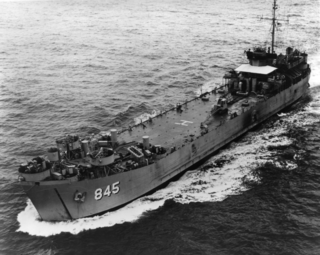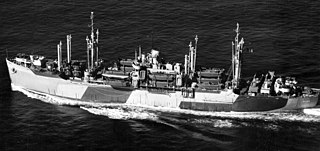
USS Hopewell (DD-681) was a Fletcher-class destroyer in service the United States Navy from 1943 to 1947 and from 1951 to 1970. She was finally sunk as a target in 1972.

USS Cabildo (LSD-16) was a Casa Grande-class dock landing ship of the United States Navy. She was named for The Cabildo in New Orleans, the old town hall and now a historical museum, where the formal transfer of the Louisiana Territory from France to the United States took place.

USS Humphreys (DD-236/APD-12) was a Clemson-class destroyer in the United States Navy during World War II. She was named for Joshua Humphreys, a pioneer US shipbuilder.
USS Cavallaro (DE-712/APD-128) was a Crosley-class high speed transport of the United States Navy.

USS Cook (APD-130) was a Crosley-class high speed transport of the United States Navy, named after two brothers: Second Lieutenant Andrew F. Cook, Jr. (1920–1942) and Sergeant Dallas H. Cook (1921–1942). Both served in the Marine Corps, and both were awarded the Navy Cross, posthumously.

USS Balduck (APD-132) was a Crosley-class high speed transport of the United States Navy, named after Marine Corporal Remi A. Balduck (1918–1942), who was killed during the Battle of Guadalcanal. For his actions he was posthumously awarded the Navy Cross.

USS Burdo (APD-133) was a Crosley-class high speed transport of the United States Navy, in service from 1945 to 1958. She was finally sold for scrap in 1967. Burdo was named after Private Ronald A. Burdo (1920–1942), a Marine who was killed in action at Gavutu, during the Battle of Guadalcanal.

The USS Weiss (APD-135/LPR-135) was a Crosley-class high speed transport in service with the United States Navy from 1945 to 1970, with two short periods spent in reserve. She was finally scrapped in 1976.

USS Jefferson County (LST-845) was an LST-542-class tank landing ship built for the United States Navy during World War II. Named after counties in 25 states, she was the only U.S. Naval vessel to bear the name.

USS Epping Forest (LSD-4/MCS-7) was an Ashland-class dock landing ship acquired by the U.S. Navy during World War II for duty in the Pacific Theater. Her task was to carry and land amphibious landing craft and other equipment and to recover and repair landing craft when possible. Named for an estate in Lancaster County, Virginia where Mary Ball Washington, mother of George Washington, was born, she was the only U.S. Naval vessel to bear the name.

USS Magoffin (APA/LPA-199) was a Haskell-class attack transport in service with the United States Navy from 1944 to 1946 and from 1950 to 1968. She was scrapped in 1980.

USS Henrico (APA-45) was a Bayfield-class attack transport that served with the United States Navy in World War II, and subsequently in the Korean War, Cold War and Vietnam War.

USS Fort Marion (LSD-22) was a Casa Grande-class dock landing ship of the United States Navy. She was named for the Castillo de San Marcos in St. Augustine, Florida, which was named Fort Marion from 1821 till 1942.

USS Wantuck (APD-125) was a United States Navy high-speed transport in commission from 1944 to 1957.

USS Horace A. Bass (DE-691/APD-124/LPR-124) was a United States Navy high-speed transport in commission from 1944 to 1969.

Crosley-class high speed transports were high speed transport ships that served in the United States Navy during World War II. Some stayed in commission long enough to serve in the Korean War and the Vietnam War. All of them were converted from Rudderow-class destroyer escorts during construction except for USS Bray (APD-139), which was converted a year after her construction. After World War II ended, several of the ships were sold to Mexico, South Korea, Taiwan, and Colombia.

USS William M. Hobby (APD-95), ex-DE-236, was a United States Navy high-speed transport in commission from 1945 to 1946.

USS Knudson (APD-101), ex-DE-591, later LPR-101, was a United States Navy high-speed transport in commission from 1944 to 1946 and from 1953 to 1958.

USS Kline (APD-120) was a Crosley-class high-speed transport in commission with the United States Navy from 1944 to 1947. She was transferred to the Republic of China Navy in 1966 and served as ROCS Shou Shan (PF-37/PF-893/PF-837) until 1997. She was finally sunk as a target in 2000.

USS Ruchamkin (APD-89), ex-DE-228, later LPR-89, was a United States Navy high-speed transport in commission from 1945 to 1946, from 1951 to 1957, and from 1961 to 1969. She subsequently served as ARC Córdoba in the Colombian Navy, until 1980; although scrapped, her hull and superstructure were re-erected in a leisure park near Bogotá.





















